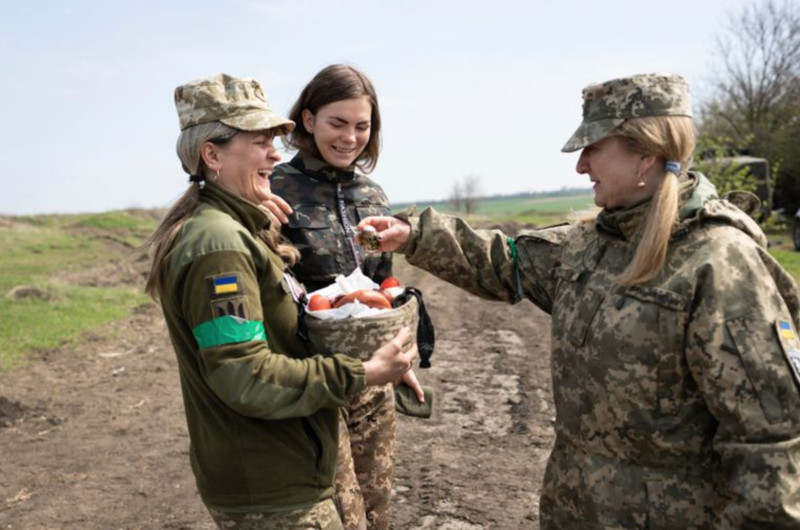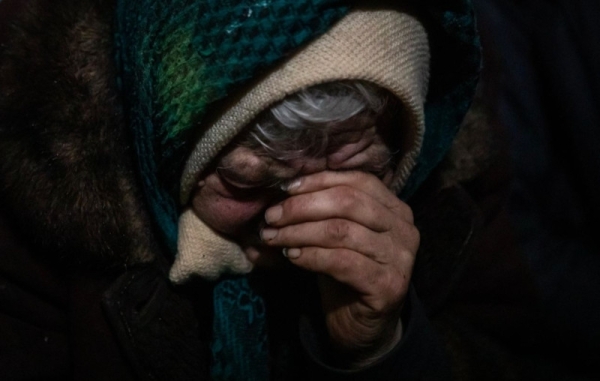How Ukrainian women’s stories became forgotten by the media
Ukrainian society increasingly recognises the importance of women’s pivotal role in the full-scale invasion of Russia in Ukraine —yet the news media is doing the opposite.
Women are "doing the unglamorous job of surviving, of keeping children safe, of supporting others. Unfortunately, this doesn’t make the news, but it is what resilience is made of too", reflects Katya Gorchinskaya, the former chief executive of the independent Ukrainian news outlet Hromadske.
-

A woman transports bottled water, February 2023, in Bakhmut, Donetsk (Photo: Yevhenii Zavharodnil/Image bank of war in Ukraine)
Ukrainians want to see women centre-stage more, but neither global nor national news media are picking up on this significant shift in social norms. This last war-torn year has seen Ukrainians become remarkably more gender-egalitarian.
In a 2022 survey, 80 percent of Ukrainians interviewed agreed that women should be granted equal opportunities to work in the armed forces vs 53 percent in 2018, while 64 percent supported equal rights for everyone, irrespective of sexual orientation vs half as many (33 percent) in 2018. In Gorchinskaya’s view, news media is missing this story because it is "considered of very low importance and priority", a viewpoint robustly supported by AKAS’ research.
Ukrainian audiences want more stories about how ordinary people live and about women’s unique war struggles within and outside Ukraine. 44 percent of women (vs 27 percent of men) surveyed in Ukraine in 2022 reported wanting more coverage of the risks that women face in times of war.
Unfortunately, Ukrainian women are now further out of news focus than a year ago.
In the immediate aftermath of the second Russian invasion, I reported that women’s share of voice as experts, protagonists or sources in global online news reporting on the war was just 23 percent. In January this year, according to the same AKAS share of voice GDELT indicator had declined further to just 18 percent.
"Strikingly, female experts in particular have disappeared from the news scene", observes Gorchinskaya. "The women I see in the media are mostly victims of the war." She argues that stories of empowered women, which Ukrainians want more of, remain on the periphery of reporting. "…A mother who ran into a burning building to save her child after a helicopter crash, women who make uniforms for service women [because there are none in the official army stock] and many others. The stories are out there."
While the UN is reporting increased levels of Russian army violence against women in Ukraine, AKAS’ analysis of GDELT (Global database of events, language and tone) data shows that the issue remains marginal in global and national news coverage of the war. Between 24 February 2022 and 29 January 2023, indicators show that 1.8 percent of the global online news coverage of the war referenced violence against women vs. 0.7 percent of all coverage in Ukraine itself.
War reporting often misses the important lens of women’s unique challenges.
Prominent Ukrainian journalists Angelina Kariakina and Iryna Slavinska share how trying it has become in recent months to maintain normal life in Ukraine. Both describe the emotional toll and personality-altering exhaustion of the compounded loss of life and the constant wrestling with power and water cuts, curfews, air raids and cold shelters. Although surprised at how quickly they have adapted to the new normal, they see the massive cost of survival, a cost we read ever less about in the news. Both journalists are currently writing about this for projects beyond their day-to-day news reporting or editing.

Understanding the health, reproductive and care-related priorities of Ukrainian women everywhere — whether civilians, soldiers, internally displaced persons or refugees — is critical if adequate policies and funds are to be designed and ring-fenced to support them.
News editors have a responsibility to give more weight to the unique angles that women war reporters bring to stories; to ensure that more women experts are featured in the news; and to focus on stories relevant to women audiences. Slavinska suggests that "in the last almost nine years of war a new generation of young women war reporters has emerged. They bring in new interesting angles. They are more likely to zone in on ordinary people, who are often ready to talk to women but not men."
However, as evidenced in From Outrage to Opportunity, traditionally male-driven editorial standards favour macro stories over micro human-centred ones, which are mostly deemed ‘non-stories’.
While finding women experts is typically more time-consuming, reaching out to less senior experts allows reporters to do so with relative ease. Since 24th February 2022, doctors (more likely to be men) have been quoted 5.3 times more frequently than nurses (more likely to be women) in global online news stories referencing the war in Ukraine, and 4.7 times more frequently in Ukrainian news, AKAS GDELT analysis shows. Balancing this ratio, finding new stories in the process, constitutes a genuine opportunity. "Recently I decided to focus on maternity hospitals and give voice to female doctors and nurses in Mariupol, Aleppo and Grozny," reveals Kariakina.
Editors need to be aware of what many news consumers who turn to ordinary people’s social media accounts of the war rather than news outlets already know: that this first draft of the history of Russia’s 21st century war against Ukraine is missing an essential part of the story.
The heroes of this war are not only the brave men and women fighting on the front lines but also those mostly women, in and out of shelters, who courageously hold society together in times of war.

